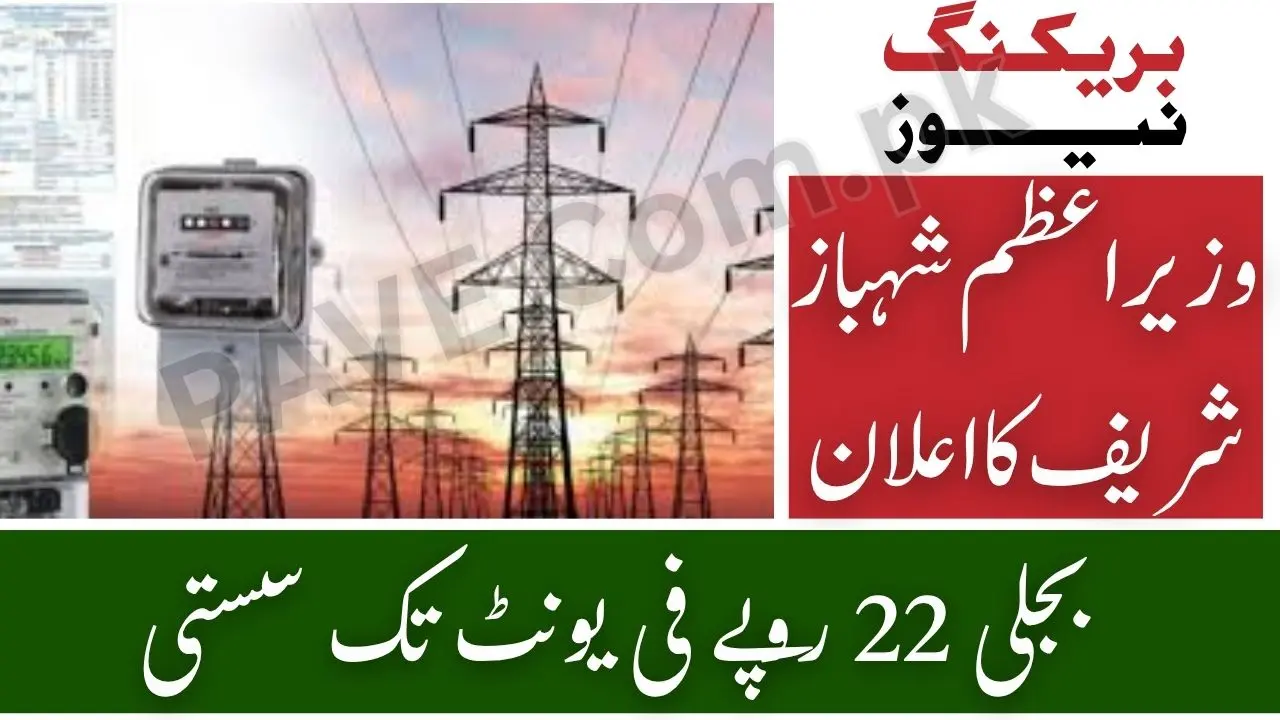Breaking News: Electricity Price Reduced to Rs 22 Per Unit — Major Relief for Consumers
Electricity Price Reduced to Rs 22 Per Unit — the Government of Pakistan has finally announced a massive power tariff reduction for citizens, industries, and farmers under a new national relief package. The long-awaited decision brings hope to millions of households burdened by high utility bills and constant tariff adjustments.
During a special cabinet meeting chaired by Prime Minister Shehbaz Sharif, the government approved a new electricity rate cut across Pakistan, bringing the cost per unit down from Rs. 34–38 to Rs. 22 only. This marks one of the biggest reductions in Pakistan’s power history, and it’s set to take effect from November 2025.
Officials confirmed that this relief plan aims to stabilize the economy, boost industrial output, and support low-income consumers through direct government subsidies — without passing the burden onto other sectors.
How Much is 1 Unit of Electricity in Pakistan?
As of November 2025, the government has officially reduced the price of 1 unit of electricity in Pakistan to Rs. 22 under the Roshan Maeeshat Electricity Package. Earlier, domestic consumers were paying between Rs. 34 to Rs. 38 per unit, depending on usage and region. This major reduction aims to provide financial relief to millions of households facing high energy costs and to make electricity more affordable for common citizens.
How Much is 1 Unit of Electricity?
Currently, 1 unit of electricity (equal to 1 kilowatt-hour or kWh) costs Rs. 22 in Pakistan for domestic and agricultural consumers. Industrial users will pay slightly higher rates depending on their consumption slab, but all sectors will receive some form of subsidy. This standardized tariff ensures fairness across provinces and helps both residential and commercial consumers manage their energy expenses more effectively.
What is the New Tariff for Electricity?
The new electricity tariff announced by the government under the 2025–2028 Roshan Maeeshat Plan sets the price at Rs. 22 per unit for most domestic and agricultural users. Industrial units will be charged around Rs. 22.98 per unit, while small businesses will benefit from a reduced average rate of Rs. 23.50. This revised tariff replaces the previous high rates and is designed to promote affordable energy access, lower production costs, and improve economic stability across Pakistan.
What is the Price of 1 Unit of Electricity in Pakistan in 2025?
In 2025, the price of 1 unit of electricity in Pakistan is officially Rs. 22, following the government’s latest announcement. The new tariff applies from November 2025 onwards and will appear in upcoming electricity bills automatically. The move is part of the broader effort to control inflation, enhance industrial growth, and support low-income families through sustainable power pricing reforms.
Govt Approves Nationwide Power Tariff Cut to Rs. 22 Per Unit
The electricity price reduction is part of the Roshan Maeeshat Electricity Package 2025–28, which focuses on energy affordability, export growth, and agriculture development.
Under the new plan:
- Domestic users consuming up to 300 units/month will enjoy direct bill relief.
- Industrial sectors will get discounted energy to enhance production capacity.
- Farmers and tube-well owners will pay Rs. 22 per unit instead of Rs. 38.
Energy Minister Sardar Awais Leghari confirmed that the government will absorb the subsidy through fiscal adjustments and international support programs.
“This is not just a political decision — it’s an economic revival plan for Pakistan,” he said during the post-meeting press briefing.
Check Also: Breaking News: Govt Announces Cheaper Electricity for Industrial and Agricultural Sectors for Next 3 Years
Major Relief for Domestic Electricity Consumers
For months, domestic electricity users have complained about unaffordable bills due to fuel price adjustments and seasonal surcharges.
Now, with the new Rs. 22 per unit electricity rate, an average household consuming 250 units monthly can save over Rs. 3,000–4,000 per bill cycle.
The Ministry of Energy also announced that November 2025 electricity bills will reflect the new reduced rates automatically. Consumers won’t need to file any special applications — the discount will appear under the “Government Relief Adjustment” line in the bill.
Officials further noted that the subsidy will be targeted to genuine users via the NADRA and NEPRA database integration system, ensuring fairness and transparency.
Industrial & Agricultural Sectors to Gain From Cheaper Power
Industrial leaders and agricultural representatives have widely welcomed the electricity tariff cut.
With power costs reduced to Rs. 22 per unit, industries such as textiles, fertilizers, cement, and steel are expected to lower production costs, enhance exports, and generate new employment.
Similarly, the agriculture sector — which depends heavily on electric tube wells — will now operate more efficiently. Farmers could save thousands of rupees monthly in irrigation costs.
Economists predict that this measure could help control inflation, as cheaper energy often leads to lower product prices in the retail market.
Check Also: Ghee and Cooking Oil Prices Increase in Pakistan 2025 — Check New Rates & Expert Analysis
Prime Minister Shehbaz Sharif’s Statement
Prime Minister Shehbaz Sharif described this as a “historic decision in favor of the people”, ensuring that every Pakistani feels relief amid economic challenges.
“We promised affordable electricity to every home and industry — today, we are delivering on that promise. No household will bear the cost of this subsidy. It’s a direct support to the people of Pakistan,” he stated.
He directed all DISCOs (Distribution Companies) to ensure accurate billing, no hidden charges, and timely reflection of the new rates.
📅 Electricity Tariff Reduction Implementation Timeline
| Phase | Period | Beneficiaries | Details |
|---|---|---|---|
| Phase 1 | Nov–Dec 2025 | Domestic & Lifeline Users | Automatic bill relief |
| Phase 2 | Jan–Mar 2026 | Agriculture & SMEs | Discounted rates |
| Phase 3 | Apr–Jun 2026 | Industrial & Export Units | Extended subsidy |
NEPRA will issue its formal notification once system recalibration is complete. The process will be monitored by a Joint Energy Oversight Committee, ensuring smooth rollout nationwide.
Economic Impact of Rs. 22 Per Unit Electricity Price
| Sector | Previous Rate (Rs.) | New Rate (Rs.) | Impact |
|---|---|---|---|
| Domestic (Up to 300 Units) | 34.00 | 22.00 | 35% drop in monthly bills |
| Industrial | 34.50 | 22.98 | Boost in production & exports |
| Agriculture | 38.00 | 22.00 | Lower irrigation costs |
| SMEs | 36.00 | 23.50 | Improved business affordability |
Economists say this reduction will stimulate growth, control inflation, and strengthen local manufacturing. The overall inflation rate could decline by 1.2–1.5% within the next quarter if the subsidy sustains.
Why This Move Was Necessary
Over the past two years, Pakistan’s electricity tariffs skyrocketed due to rising international fuel prices and circular debt.
The government’s new initiative — Electricity Price Reduced to Rs. 22 Per Unit — aims to restore economic stability while protecting low-income families.
The Roshan Maeeshat Electricity Package 2025–28 will also promote renewable energy, solar adoption, and smart grid technologies, gradually reducing dependency on imported fuel.
Public Reaction to Electricity Price Reduction
Many consumers expressed hope that this decision will bring real financial ease and lower inflation in daily essentials.
Business groups also hailed the decision as a “game-changer for industrial revival”, saying cheaper energy will attract investors and boost exports.
Challenges Ahead
Experts caution that the government must ensure efficient power distribution to sustain the subsidy. Key challenges include:
- Power theft and unpaid bills in high-loss areas.
- Maintaining international energy imports at stable prices.
- Ensuring NEPRA and DISCO coordination.
- Monitoring fiscal pressure on the national budget.
Energy experts suggest that long-term stability will depend on reforms in the power purchase agreements (PPAs) and domestic renewable production.
Government’s Vision for Sustainable Energy
The Energy Division has announced plans to install solar power systems at public institutions and encourage private net-metering.
This strategy aims to reduce dependency on thermal generation and maintain the new Rs. 22 tariff sustainably.
The government is also expanding local coal and hydropower projects, aiming to achieve 40% renewable mix by 2030.
Check Also: Breaking News: Sindh to Change Intermediate Syllabus and Launch Daily Library Classes 2025
Conclusion: A Milestone in Power Sector Reform
The announcement that Electricity Price Reduced to Rs. 22 Per Unit is a turning point for Pakistan’s economy. It brings direct relief to citizens, supports industries, and encourages agricultural expansion.
If implemented transparently, this could mark the beginning of long-term economic recovery and energy stability in Pakistan.
FAQs — Electricity Price Reduced to Rs 22 Per Unit in Pakistan:
1. What is the new electricity rate announced by the government?
The government has reduced the electricity rate to Rs. 22 per unit, effective from November 2025, under the Roshan Maeeshat Electricity Package.
2. Who will benefit from the new Rs. 22 per unit electricity rate?
All domestic, agricultural, and industrial consumers — especially those using up to 300 units/month — will benefit from this relief package.
3. Do consumers need to apply for the electricity relief?
No. The discount will be automatically applied to electricity bills starting November 2025 under the label “Government Relief Adjustment.”
4. How will the government finance this subsidy?
The federal government will cover the cost through fiscal adjustments, improved recovery systems, and international support programs.
5. How long will the Rs. 22 per unit tariff remain in effect?
The subsidy package will remain valid for three years (2025–2028), subject to annual review by NEPRA and the Ministry of Energy.







